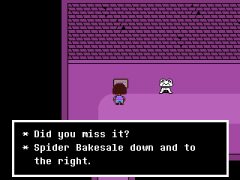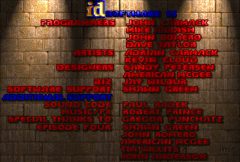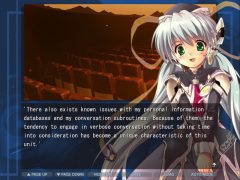As I mentioned in my previous post, I’ve been trying to devote my weekends to playing through at least one indie game. I’ve stuck with that through April, though two of the games I played this month are, while made by small teams, technically not indie: the first is the most famous title from a storied Western developer, and the other, though lesser-known, is by one of Japan’s most celebrated makers of all-ages visual novels. Also, I didn’t actually start the former game during the weekend, but I digress. Without any further ado, here are those games for the month of April 2016, indie or not, weekend or not.
Filled with Determination – April 2-3:
Undertale (2015, tobyfox)

The tone throughout much of Undertale is contemporary and humorous, with some nods to otaku subculture in particular, plus a few (and thankfully, only a few) fourth-wall breaking moments and overt references to other games. Undertale‘s most obvious antecedent is Earthbound, another story centered around a child on an unexpected journey, but fortunately, it has none of its spiritual predecessor’s blatant patronization nor its interface and inventory flaws. Cave Story seems to be another inspiration, in part due to the underground setting and relatable characters, as well as the MegaTen series, via its comparatively simple conversation system. However, it’s impossible to truly say “it’s like (blah) crossed with (blah)” in regards to Undertale; as a complete package, there’s nothing else quite like it. I highly recommend this odd yet rewarding indie morsel, and also that new players go in knowing as little about it as possible.
Hell is a Place on Deimos – April 11-14:
Doom (1993, id Software [via Doom 3: BFG Edition, 2012])

Doom‘s sprawling, labyrinthine levels are, save for one or two badly-implemented sections, still some of the best ever made; the enemies have a good range of toughness and attack types; and the weapons all feel right. Also, despite Doom‘s dated controls—for example, horizontal-only mouselook and no jumping—they never feel limiting thanks to some smart design. The fourth episode, which was made sometime after the completion of the main three, is more unbalanced than the others, but the blemishes that it adds to the whole are minor. By the way, the story, which involves a space marine and a portal to Hell, is as silly a bit of fluff as ever.
Ephemeral Stars – April 17-18:
planetarian ~the reverie of a little planet~ (2004, Key [via English ver., 2014])

planetarian takes place is a post-apocalyptic world upon which pours an endless, poisonous rain. The nameless protagonist, a manly tsundere scavenger, comes across a well-preserved planetarium, maintained by an android named Hoshino Yumemi. She is a waifu-candidate type of moe character: unfailingly positive, eager to please, and with quirks intended to cross the line from annoying to charming. Key is famous for their sentimental stories, and in that respect, planetarian does not disappoint; the middle chapters in particular are a highlight. However, I found the melodrama to be mawkish at times, and the repetition of certain story beats didn’t seem to work as well as they would in a serialized format. Despite these issues, a handful of typos and some peculiar grammatical choices, and the rare bit of thesaurus porn (for example, “demesne”, which was used metaphorically), the story and localization were all right, but nothing truly special. On the whole, planetarian has some charms, but is most definitely not for everyone. At least I can say that I’ve experienced a Key visual novel now.
A Spirited Journey – April 23-24:
Never Alone (Kisima Ingitchuna) (2014, Upper One Games/E-Line Media)

The stories themselves, about an endless blizzard and a journey across water, are imaginative in a way that isn’t unexpected for traditional tales, and are more than suitable for a video game. Much of the puzzle-platforming is dependent on cued changes in the environment. While this works well enough in some sections, it feels slightly less so elsewhere, and some instances of clipping and slightly jerky animation don’t help. The checkpointing is fairly good, though, so there’s few frustrations to be had. I also must make note of the unlockable “Cultural Insight” videos, mini-documentaries about the Iñupiat people that are relevant to the game; as they provide a great deal of context about the game, they are worth checking out. It’s a well thought-out little game, despite its few flaws.
So, that about covers this month. I also played plenty of Diablo III and Bravely Default this month, and am currently nearing the ends of both of those; I’ve also recently started a replay of Doom II. As for what May will bring, I may cut back on the Weekend Indies for awhile and concentrate more on the longer games I have backlogged. We’ll see how it goes.